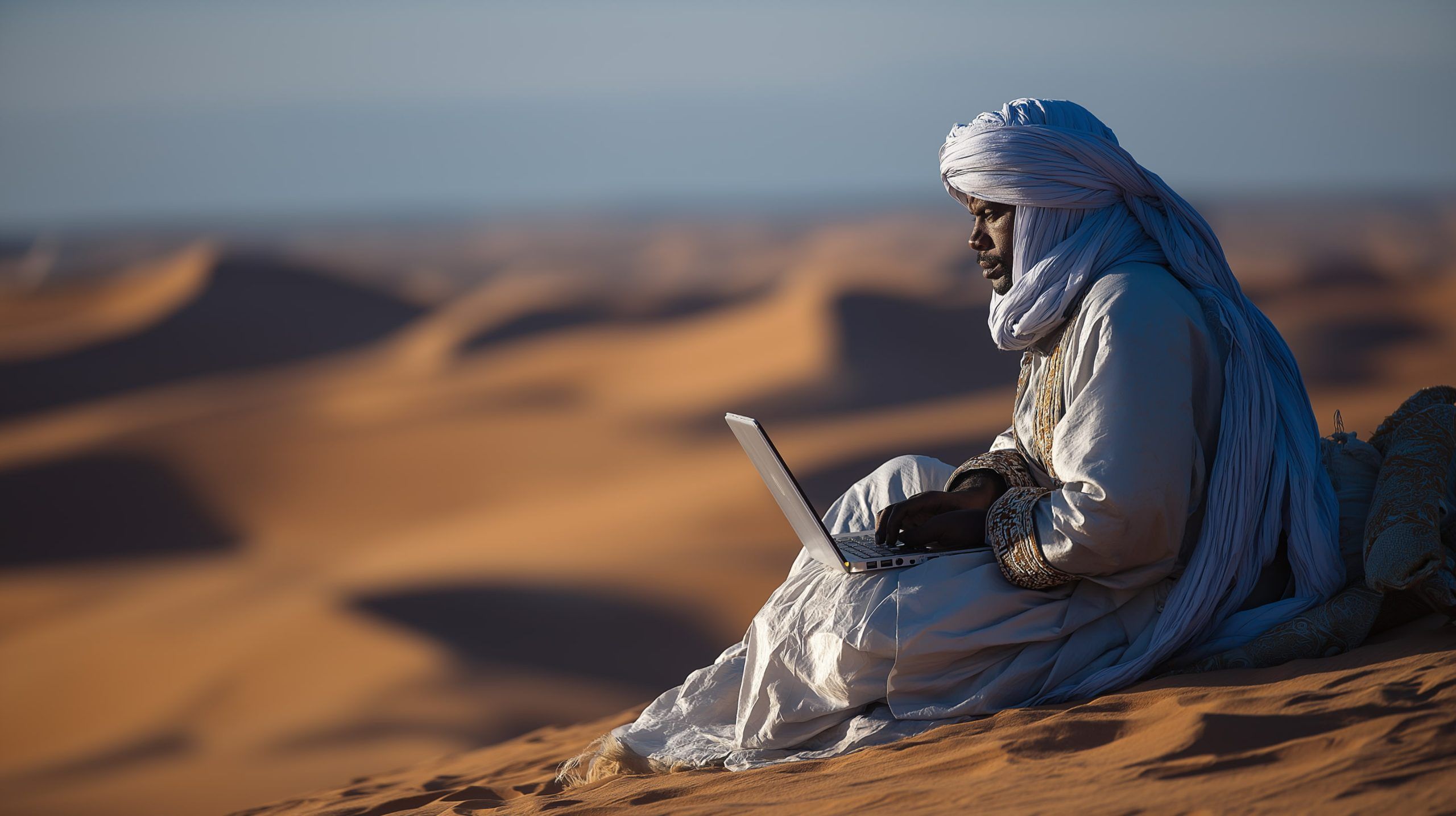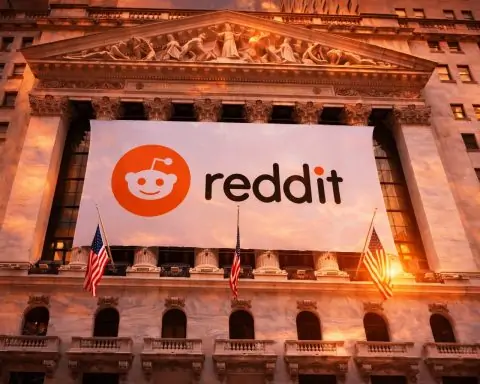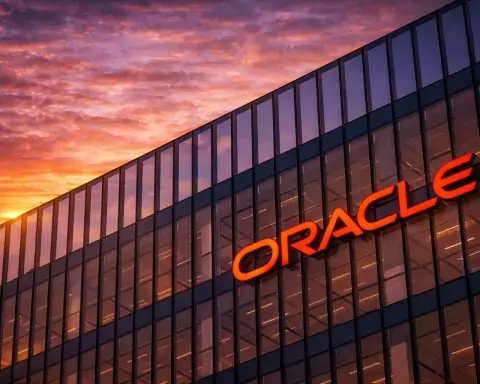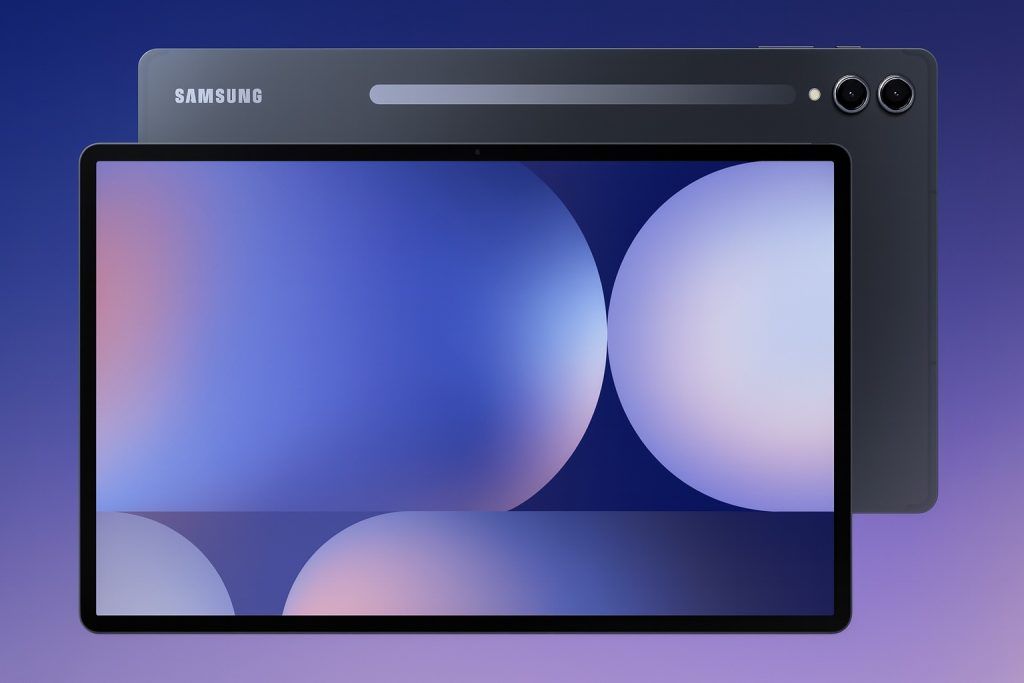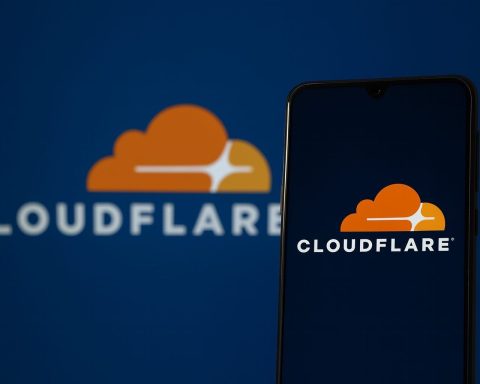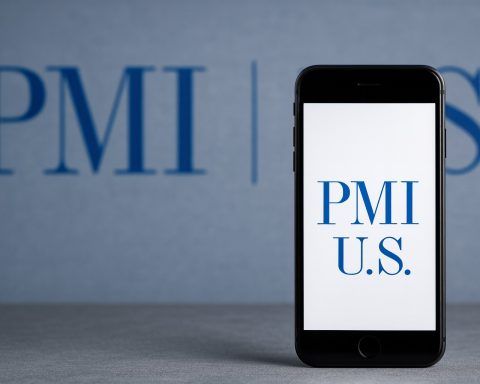- The Sahara spans about 9 million square kilometers (3.6 million square miles) across North Africa and covers ten countries: Algeria, Mali, Niger, Chad, Libya, Sudan, Egypt, Mauritania, Morocco, and Tunisia.
- A Trans-Saharan Fiber Backbone is under development to connect Algeria, Mali, Niger, Nigeria, Chad, and Tunisia along the Trans-Saharan Highway, tying inland towns to multiple submarine cable gateways, with Chad’s 559 km link from N’Djamena toward the Niger border nearly finished by late 2024.
- Chad obtained its first international fiber link in 2012 and today still has no nationwide fiber backbone connecting its towns.
- Only about 10–12% of Chadians have electricity at home, with rural areas in the single digits, forcing towers to run on diesel generators or solar panels.
- Starlink expanded across Africa with Nigeria as the first African country to license it in early 2023, 18 African countries with service by end of 2024, Chad licensed in November 2024 and live by March 2025, and initial Chad tests showing speeds up to 150 Mbps.
- OneWeb, now part of the European group Eutelsat, is deploying a global LEO constellation, and Morocco is seeking to license OneWeb while also pursuing a new high‑throughput satellite with Thales Alenia Space in 2023 to cover Africa.
- In Mali, Orange partnered with Intelsat to deploy the first satellite-powered 4G network in West Africa, boosting backhaul from 200 Mbps to over 5 Gbps and connecting about 360,000 people in rural sites.
- Data costs in Chad around 1 GB were about $23 in 2021 (over 20% of monthly income), while the Alliance for Affordable Internet targets 1 GB for no more than 2% of income, and a typical 1.5 GB plan can cost roughly 5,000 CFA (about $8).
- The World Bank’s Chad Digital Transformation project (2024–2029) is a $92 million program to connect 4.5 million rural Chadians and provide digital skills training and online government services.
- Connectivity is transforming Saharan communities through education and commerce, with e-learning in Western Sahara towns, diaspora tutoring for Sahrawi students in Algeria, mobile banking, and activist reporting via social media and satellite links.
Introduction: The image of the Sahara Desert typically evokes endless dunes and remote oases – not Wi-Fi signals. Yet in today’s world, even this vast expanse is inching its way online. Spanning roughly 9 million square kilometers (around 3.6 million square miles) across North Africa, the Sahara is the largest hot desert on Earth [1]. It stretches across or borders about ten countries – including Algeria, Mali, Niger, Chad, Libya, Sudan, Egypt, Mauritania, Morocco, and Tunisia – each grappling with the challenge of bringing internet connectivity to some of the most remote communities on the planet. The harsh environment and low population density long left many Saharan areas “digital black holes” with virtually no reliable internet or mobile service [2]. Recently, however, technological breakthroughs and policy initiatives have sparked hope for a more connected future in this “digital desert.” Below, we explore the current state of internet infrastructure in the Sahara, the rise of satellite internet solutions like Starlink and OneWeb, the unique challenges to connectivity, efforts to bridge the digital divide, the costs of getting online, and how access to the internet is transforming Saharan societies.
The Sahara’s Internet Landscape: Fiber, Mobile, and Satellite
Building traditional internet infrastructure in the Sahara is a monumental task. Fiber-optic cables – the backbone of high-speed internet – do exist in the region but mainly along limited routes and borders. In fact, a major Trans-Saharan fiber backbone is under development to connect North and West Africa: a project linking six countries (Algeria, Mali, Niger, Nigeria, Chad, and Tunisia) by laying fiber alongside the Trans-Saharan Highway [3]. This new backbone aims to tie remote interior nations into multiple undersea cable gateways – for example, giving landlocked Chad access to submarine internet cables via Niger and Algeria [4]. Such projects are slowly improving core connectivity between countries. Within nations, fiber links typically reach major cities or mining towns at the desert’s edge, but vast interior zones still lack any fiber lines. The economics are daunting: running cables across hundreds of kilometers of empty desert to reach small settlements yields little return on investment. As a result, until recently much of the Sahara had no wired broadband at all. For example, Chad only obtained its first international fiber link in 2012 – before that it relied entirely on expensive satellite uplinks – and even today it still has no nationwide fiber backbone connecting its towns [5] [6].
Mobile networks serve as the primary on-ramp to the internet for most Saharan populations, but coverage is mostly limited to population centers and transit corridors. In the few cities, oases, or border towns, residents can often get 3G or 4G service from national carriers. However, venture beyond these pockets of civilization and the signal bars vanish quickly. In Chad, for instance, about 85% of people are covered by basic 2G cellular signals (enough for calls or texts), yet only ~25% of the population is within range of 3G or 4G data coverage – essentially just the major urban areas [7]. Large swathes of rural Sahara have no cell towers at all, meaning no phone or data service for hundreds of kilometers. Highways crossing the desert often pass through “dead zones” with zero reception [8]. Even where there is cellular coverage, network quality can be poor. Desert cell sites are often far apart, leading to weak signals, and limited bandwidth on the backhaul links means slow speeds for users. In one survey, 86% of internet users in Chad described their connection as “slow” [9]. Given the scarcity of fixed-line broadband (in Chad virtually no one has a home fiber/DSL connection [10]), mobile networks are indeed lifelines – but an unreliable one in the deep Sahara.
Where neither fiber nor cell towers reach, satellite internet has historically been the only option – albeit an expensive and limited one. Legacy VSAT (very small aperture terminal) satellite links have been used sparingly in the desert for decades: for example, to connect remote mining camps, military outposts, or UN mission stations where no other network was available [11]. These traditional satellite connections were slow and costly, often offering dial-up to basic DSL speeds at a high price [12]. Consequently, they never scaled to serve the general public. A nomadic herder or a small village could not realistically get online via old-school satellite except in emergency situations. That paradigm is now changing with the advent of new satellite technologies (discussed next). But as of the past few years, the typical connectivity landscape in the Sahara remained patchy: a few fiber-optic veins along highways, spotty mobile coverage around towns and roads, and satellite links filling in only for critical uses. It’s a stark contrast to more populated regions – many Saharan communities went from the 20th century into the 21st with virtually no internet at all.
The Satellite Revolution: Starlink, OneWeb, and Internet from the Sky
Recently, a game-changer has arrived above the desert: low-Earth orbit (LEO) satellite constellations that beam internet down from the sky. The most famous is SpaceX’s Starlink, which by 2023 had blanketed the skies over North Africa with hundreds of satellites [13]. Starlink promises high-speed broadband (100–200 Mbps) with low latency via a small dish – potentially bringing connectivity to any point on Earth within its coverage footprint [14]. For a region like the Sahara, where “terrestrial” networks fail to reach, this is revolutionary. However, Starlink can only operate in a country with government permission. Throughout 2023–2024, SpaceX engaged in negotiations with many African governments to obtain licenses. Progress has been rapid: Nigeria became the first African country with Starlink in early 2023, and by the end of 2024 Starlink was active in 18 African countries [15] [16]. In 2024, Starlink launches included several Sahel/Sahara-region states – for example, Niger’s military government granted Starlink a license in late 2024 and the service went live there by March 2025 [17]. Chad approved Starlink in November 2024, seeing it as a way to leapfrog its lack of fiber; by early 2025 Starlink announced it was “available in Chad” to begin serving customers [18]. The Chadian government highlighted that “a large part of our territory is not covered by fibre optics, and Starlink will help bridge this gap” [19]. Indeed, initial tests in Chad showed download speeds up to 150 Mbps via Starlink – a dramatic improvement for a country where rural users previously struggled to get even 1 Mbps on aging 2G/3G networks [20].
Other satellite providers are also joining the fray. OneWeb, now part of the European satellite group Eutelsat, is deploying another LEO constellation that aims to provide broadband coverage globally. Morocco (which has a strategy to connect 100% of its territory) has been looking to license OneWeb as well, likely to use it for enterprise and cellular backhaul rather than individual consumers [21]. Additionally, Morocco is investing in its own satellite capacity – a Moroccan consortium partnered with Thales Alenia Space in 2023 to develop a new high-throughput satellite covering Africa [22] [23]. This could give the region even more bandwidth and give governments greater control over connectivity from space. Traditional satellite companies, too, remain vital. For instance, Intelsat (a geostationary satellite operator) has helped mobile carriers extend coverage in Saharan countries. In Mali, Orange partnered with Intelsat to deploy the first satellite-powered 4G network in West Africa, massively increasing its capacity to serve remote areas. Using two Intelsat satellites, Orange Mali boosted its satellite backhaul from just 200 Mbps to over 5 Gbps, enabling reliable 3G/4G in more than 60 isolated sites across the country [24] [25]. Thanks to this project, some 360,000 people in previously unreachable rural Mali now have connectivity [26]. This underscores that multiple satellite approaches – from high-orbit traditional satellites to new LEO swarms – are complementing each other to reach where ground networks cannot.
While satellite internet is opening the skies, there are still hurdles. The cost of LEO satellite service can be steep for ordinary citizens. Starlink’s equipment in developing countries runs a few hundred dollars upfront, and subscriptions in Africa are around $50 per month or more [27] [28]. In Chad, $50 is beyond the entire monthly income of many households [29]. Governments are aware of this and are exploring ways to subsidize or share connections. Morocco, for example, has discussed providing grants up to 2,500 Moroccan dirhams (about $250) to rural users towards the cost of satellite gear [30]. Some Saharan governments plan to deploy Starlink at community centers, schools, and clinics – creating shared access points rather than expecting each family to afford their own dish [31] [32]. Also, even satellite needs power: off-grid villages must install solar panels and batteries to run the satellite terminals, adding to setup complexity [33] [34]. Nonetheless, the trajectory is clear: satellite broadband is moving from a niche last resort to a mainstream piece of the Sahara’s connectivity puzzle [35]. Every corner of the desert, from a nomads’ encampment to a border checkpoint, could theoretically come online via “internet from the sky.” And in crisis situations – whether natural disasters or government-imposed communication blackouts – satellites offer a resilient lifeline when other networks go down [36]. In short, the Sahara’s most remote outposts may soon be just a dish away from the global internet.
Barriers to Connectivity: Geography, Politics, and Technical Challenges
Why has connecting the Sahara been so difficult? The obstacles are as vast as the desert itself, spanning natural, economic, and political domains:
- Distance and Geography: The Sahara’s sheer size and emptiness make traditional telecom expansion prohibitively difficult. The desert covers an area comparable to the United States, yet its population is tiny and widely dispersed. This low population density makes it economically unfeasible for operators to build infrastructure like cell towers or fiber lines in most areas [37]. There are simply not enough paying customers per square kilometer to recoup the investment. A fiber-optic cable might stretch hundreds of kilometers to connect two oasis towns with only a few thousand inhabitants in between. Likewise, a cellular tower in the middle of nowhere might only serve a highway or a handful of nomadic families – not exactly a profitable venture. The geography is also brutally hard on infrastructure: rolling out fiber or power lines over shifting sand dunes and rock is an engineering nightmare. Maintenance crews face long journeys just to repair a downed line or a broken generator. As a result, companies historically focused on the easier wins (cities and dense villages), leaving “hundreds of kilometers of sand” in between with no signal [38] [39]. Even today, vast stretches of the Sahara rely on 2G radio or satellite phones if they have any service at all [40].
- Harsh Climate and Terrain: The environment itself conspires against connectivity. Blistering heat (often over 45°C / 113°F in summer), sandstorms, and lack of water all wreak havoc on equipment [41]. Electronics exposed to sand and dust can overheat or corrode. Solar-powered installations (a common solution for off-grid towers) get covered in dust, reducing their output. Remote towers and satellite dishes must be built to withstand fierce winds and abrasive sand. In parts of Western Sahara and Libya, there’s even the danger of old landmines in the ground, complicating construction of new cable routes [42]. The climate means higher maintenance costs – gear might fail faster, and sending technicians for repairs is slow and expensive.
- Power and Electricity Gaps: No power, no internet. Electricity is extremely scarce in rural Sahara, and this is a fundamental barrier to connectivity. Many desert villages are not connected to any national power grid. For example, only about 10–12% of Chadians have electricity access at home (and in rural areas it’s in the single digits) [43] [44]. This means cell towers and internet hubs must run on diesel generators or solar panels, which can be unreliable. Generators need constant fuel deliveries – a challenge across desert distances – and they break down often. It also means people can’t easily charge their phones or laptops. In villages, it’s common for people to travel miles or pay a fee to charge a phone from a car battery or a solar kiosk [45]. The lack of basic electrical infrastructure raises the cost of every internet project and often leaves telecom equipment literally in the dark. Until rural electrification improves (many countries have targets to boost power access by 2030, but from a very low baseline [46] [47]), keeping networks running in the Sahara will remain an uphill battle.
- Economic Constraints: The poverty of many Saharan communities creates a vicious cycle for connectivity. On the provider side, the low incomes mean people have limited ability to pay for internet service or devices, reducing the business incentive to invest. On the consumer side, even where networks are available, many simply cannot afford to get online (we will detail pricing in the next section). The result is that companies hesitate to build in poor, sparsely populated areas, which then remain offline and economically stagnant – a classic development catch-22. Additionally, the countries that govern the Sahara region often rank low on GDP and have limited budgets to subsidize telecom infrastructure. They face competing priorities like food security, health, and security. Thus, government investment in ICT for remote areas, while growing, has historically been minimal beyond headline projects. In short, there has been a market failure in connecting the desert: neither the private sector nor cash-strapped governments found it viable to spend heavily on infrastructure for so few users. This dynamic is slowly changing with international aid and cheaper technologies, but the economic hurdle is still very real.
- Political Instability and Policy Barriers: Parts of the Sahara are plagued by conflict and political instability, which directly undermines connectivity. Northern Mali, eastern Libya, parts of Chad, and Sudan’s Darfur region have all experienced armed conflicts or insurgencies in recent years. In such areas, telecom towers have been targets of vandalism or military strikes, and technicians cannot safely maintain infrastructure. Decades of instability in Mali, for example, hindered the expansion of broadband networks and led to frequent service disruptions [48]. Even when physical security isn’t an issue, politics can interfere in other ways. Some regimes have restricted internet access deliberately for control. A stark example is Chad: in 2018, after anti-government protests, authorities imposed a social media blockade that lasted over a year, cutting off Facebook, WhatsApp, and Twitter to millions of users [49] [50]. It was the longest such shutdown ever recorded in Africa and was justified by officials under “security” concerns. Similar shutdowns or throttling have occurred during unrest or elections in Sudan and Mali as well. These practices obviously set back digital development and erode public trust in the network. Additionally, complex regulatory environments can slow innovation – for instance, countries that require heavy licensing fees or local ownership for ISPs can deter new entrants (South Africa’s stringent rules have delayed Starlink’s entry, for example [51] [52]). In summary, the Sahara’s connectivity challenge isn’t just technological – it’s also about governance. Places with stable, forward-looking policies (like Morocco’s push for universal coverage) tend to have better internet outcomes than those mired in conflict or heavy-handed internet control. Political will can make the difference between treating the internet as a public necessity versus a luxury to be dispensed (or withheld) at the regime’s whim.
All these factors – geographic, climatic, economic, political – intertwine to make the Sahara one of the hardest places on Earth to get online. The challenges are immense, but as the next section shows, there are numerous initiatives underway to overcome these hurdles and connect the unconnected.
Bridging the Gap: Initiatives to Connect the Desert
Despite the obstacles, governments and international partners are actively working on projects to drag the Sahara online. These initiatives range from large-scale infrastructure investments to innovative local solutions:
- Transnational Fiber Projects: One major effort is the Trans-Saharan Fiber Optic Backbone (TSB) project under the African Union’s development plans. As noted, this plan is building fiber along the Trans-Saharan Highway route to interconnect Algeria, Niger, Nigeria, Chad, Mali, and Tunisia [53]. By tying into coastal cables in multiple directions (Mediterranean, Atlantic, and Red Sea), it will give landlocked Saharan countries redundant paths to global internet bandwidth [54]. Sections of this backbone are nearing completion. In Chad, for example, a new 559 km fiber link from the capital N’Djamena toward the Niger border is almost finished (as of late 2024, only ~100 km remained) [55]. Funded by the EU and African Development Bank, this link – along with a spur to Sudan – will end Chad’s reliance on a single fiber route through Cameroon [56] [57]. By early 2025, Chad expects to light up this network, gaining access via Niger to multiple submarine cable landing points and dramatically improving its internet resilience [58]. Similarly, Mauritania is taking part in new trans-African fiber systems and expanding its 3G/4G coverage, aiming to connect more of its vast interior [59] [60]. These backbone projects, often supported by international organizations, lay the groundwork so that even inland desert towns can eventually get fiber connectivity to the outside world.
- Mobile Network Expansion and Innovation: National telecom operators are slowly extending their reach further into remote areas. Several countries have “universal service” funds or rural coverage targets that push telcos to cover more territory. For instance, both Airtel and Moov in Chad have been rolling out 4G in secondary towns and along key roadways as encouraged by the government regulator [61] [62]. In Algeria and Morocco, state-led programs have subsidized the building of mobile towers in under-served southern regions (often solar-powered towers to operate off-grid) [63]. Solar-powered cell sites are a promising solution – by using renewable energy, they can bring coverage to an isolated village without needing a generator or grid hookup [64]. Telecom companies and startups are also experimenting with portable “pop-up” networks. These are mobile base stations that can be quickly deployed for temporary events, research expeditions, or emergency response in the desert [65]. While such solutions are still in pilot phases, they demonstrate creative ways to extend mobile coverage on an as-needed basis. Another strategy is leveraging existing infrastructure – for example, along the Trans-Saharan Highway or oil pipelines, operators can piggyback fiber or microwave links and install towers at regular intervals to cover those routes. In Mali, Niger, and Chad, some highways now have 2G/3G signal in spots where just a few years ago there was none, thanks to these incremental expansions (often in conjunction with donor-funded projects).
- Satellite Connectivity Programs: Embracing satellite is a key initiative across the region. Governments are not only licensing Starlink and OneWeb but also integrating satellite into public services. Community Wi-Fi hubs fed by satellite are being set up in extremely remote settlements. These may be as simple as a Starlink dish at a village school or health clinic, broadcasting a Wi-Fi signal for the local population. For example, the government of Chad, after authorizing Starlink, indicated it would prioritize connecting schools, community centers, and hospitals in rural districts using satellite terminals [66] [67]. Such shared access points can dramatically change day-to-day life (allowing villagers to, say, download government forms or make a WhatsApp call, even if they don’t personally own a satellite dish). International NGOs and agencies are supporting some of these efforts. The UNDP and ITU have helped establish “digital community centers” in a few Saharan towns – solar-powered sites where people can access computers, the internet, and digital training [68] [69]. Satellite links are often the only viable backhaul for these centers. In refugee camps at Tindouf (southwestern Algeria) housing Sahrawi refugees from Western Sahara, aid organizations have installed VSAT internet to enable basic email, VoIP and educational content delivery since around 2010 [70] [71]. Looking ahead, some countries plan to subsidize consumer satellite broadband for the hardest-to-reach populations. Morocco’s telecom authorities, for example, signaled they would treat satellite broadband as part of achieving universal service and possibly help lower the cost for rural subscribers [72] [73]. All these moves point to a recognition that satellites will play a permanent role in closing the last gaps.
- International Donor and Development Projects: The Sahara’s connectivity gap has caught the attention of global development organizations. The World Bank, African Development Bank, and others have launched programs to fund digital infrastructure and literacy. One notable example is the World Bank’s “Chad Digital Transformation” project (2024–2029) – a $92 million initiative to expand affordable broadband access and e-government services across Chad [74]. This project aims to connect 4.5 million more Chadians in rural areas through a mix of fiber extensions, microwave relays, and satellite links [75] [76]. It also includes digital skills training for tens of thousands of citizens and the creation of online government platforms for things like electronic ID, e-health, and digital payments [77]. In Mali and Niger, similar donor-backed programs are underway to rebuild telecom infrastructure and extend connectivity following periods of conflict and neglect. Central African Backbone (CAB) projects (supported by the World Bank) have laid some fiber through Chad and connected it to Cameroon and Central African Republic [78]. In Sudan, before the recent conflict, international partnerships were improving rural mobile coverage and introducing 4G in more provinces. Even conflict-torn South Sudan (just south of the Sahara) recently partnered with Intelsat and an NGO to bring satellite internet to remote community centers, highlighting that no area is being written off [79] [80]. These initiatives often pair infrastructure with capacity-building – setting up telecenters, training youth in IT skills, and promoting locally relevant content or services. The holistic approach is important: it’s not just about cables and satellites, but also ensuring people have the know-how and reasons to use the internet when it arrives.
- Local Innovations and Community Networks: On a smaller scale, there are grassroots attempts to bridge connectivity gaps. In some Saharan communities, enterprising locals or NGOs have created DIY Wi-Fi networks by linking a few long-range Wi-Fi transmitters to a single satellite or microwave connection. These can cover a village with basic internet at a lower cost than official telco infrastructure (though performance is limited). There have also been experiments with balloon or drone-based coverage (like Google’s Project Loon, which in 2020 tested high-altitude balloons to provide internet in Kenya). While Loon was discontinued, the concept of aerial platforms to fill coverage gaps may resurface to serve remote deserts. Another innovation is the use of TV white spaces and other alternative spectrum to deliver rural broadband – essentially using unused broadcast frequencies to carry internet to far-off areas. Trials of such technology in parts of Africa have shown promise for low-cost, if moderate-speed, connectivity over several kilometers radius, which could be applicable to sparsely populated areas. Finally, some countries encourage the formation of community networks – where local cooperatives set up and manage their own communications (often with support from tech charities). These bottom-up networks can be as simple as a village sharing one satellite link, or as elaborate as a mesh network across multiple oasis towns. While none of these will singlehandedly solve the Sahara’s digital divide, they add up to a mosaic of solutions tailored to local needs.
From continental fiber highways to tiny solar-powered Wi-Fi cafés, the range of initiatives in motion is impressive. The overarching trend is that connectivity is now seen as a necessity, not a luxury, even for remote Sahara communities. National plans like “Digital Mali 2025” or “Chad Digital 2030” explicitly recognize that bringing the internet to villages will spur economic growth and social development [81] [82]. There is also a spirit of cooperation – countries are banding together on regional infrastructure, and public-private partnerships are common in these projects. The challenges aren’t solved overnight, but the groundwork is being laid to ensure that even someone living in the deep Sahara won’t remain offline forever.
The Price of Connection: Internet Costs and Affordability
One of the biggest ongoing concerns is affordability – having an internet connection is one thing, but being able to pay for it is another. Across Saharan Africa, the cost of data and devices remains a significant barrier for ordinary people:
Data Prices: Mobile internet data in several Saharan countries is among the most expensive in the world relative to income. Chad provides a dramatic example: a 2021 global survey ranked Chad the 5th most expensive country for mobile data, with an average price around $23 for just 1 GB [83] [84]. For context, 1 GB of data costs under $1 in many other African countries and is a trivial expense in wealthy nations. In Chad, that 1 GB price tag represented over 20% of an average person’s monthly income – an “astronomical burden,” as analysts noted [85] [86]. The Alliance for Affordable Internet (A4AI) recommends 1 GB of mobile data cost no more than 2% of monthly income, by comparison [87]. It’s a similar story in other low-income Sahel states: the DRC and Central African Republic, which border the Sahara, also suffer from data plans consuming >20% of typical income [88]. In such places, mobile internet is essentially a luxury for the well-off [89]. A basic monthly bundle – say 1.5 GB of data – might cost ~5,000 CFA ($8) in Chad [90], a country where many earn only a few dollars a day. The average nomad or farmer cannot spend that kind of money regularly just to be online. By contrast, some North African countries have achieved far cheaper rates. Egypt and Tunisia, for example, boast some of Africa’s most affordable internet, with average broadband packages around $10–$15 per month [91]. These lower prices stem from more competitive markets, better infrastructure, and government efforts to drive down costs. Sudan was even cited in early 2024 as having one of the world’s cheapest average internet costs (around $2.40 per month) [92], though this figure is skewed by currency fluctuations and belies Sudan’s huge urban-rural gap. In Western Sahara, where Moroccan operators provide service, the government has kept mobile data prices uniform with the rest of Morocco – meaning relatively cheaper than in Mauritania or Mali – as part of subsidizing the region [93] [94]. Even so, a high-end broadband plan (fiber or satellite) in Western Sahara “costs more than many people’s monthly income,” illustrating that price remains a limiting factor on adoption [95] [96].
Fixed Broadband and Equipment Costs: For the few who might want a home broadband connection in the Sahara (in areas where it’s even available), the costs are typically prohibitive. Fixed-line internet is extremely rare – e.g., the World Bank recorded essentially 0% fixed broadband subscription in Chad in recent years [97] – and one major reason is price. In N’Djamena (Chad’s capital), an unlimited home broadband via satellite or ADSL was quoted around 250,000 CFA per month (~$415) for a 60 Mbps plan [98] [99]. This is far beyond the reach of anyone but large corporations, international NGOs, or perhaps government offices. Even a slower DSL plan or home 4G router package can run dozens of US dollars per month in many Saharan countries. Additionally, the upfront cost of equipment is a hurdle. Many families do not own a computer, and even smartphones – which are the primary internet device in Africa – can be expensive relative to incomes. In Chad, fewer than half the people have a smartphone capable of using the internet [100]. The others have basic feature phones or no phone at all. So even if mobile data became cheap, a significant portion of the population couldn’t go online without upgrading their device. And for satellite services like Starlink, as noted, one must purchase a kit that can be $300–$600 depending on region – utterly unrealistic for a rural household living on subsistence farming. Electricity costs tie in here too: those without reliable power may need to pay extra to charge devices (some villages literally charge phones for a fee), and ISPs must spend on generators, a cost that trickles down to the consumer tariffs [101] [102].
Strides Toward Affordability: Recognizing these issues, various measures are being taken to make internet access more affordable in the Sahara. Some governments have cut telecom taxes or fees to encourage lower prices. Others have introduced more competition – for example, Sudan licensed new private ISPs a few years ago which helped drive prices down (though recent conflicts disrupted this progress). The A4AI and Internet Society are working with countries like Chad and Mali on policies to achieve the “1 for 2” affordability target (1 GB for 2% of income) [103] [104]. In many places, prices are slowly trending downward as infrastructure improves. Chad, while still extremely expensive, has seen data costs dip slightly from their peak and providers offering promotions like social bundles (unlimited WhatsApp or Facebook for a low fee) to attract users [105]. Subsidy programs are also part of the toolkit: as mentioned, Morocco plans to subsidize rural satellite broadband [106], and Chad’s government has floated ideas like community Wi-Fi with free or cheap access at certain times. Additionally, big tech companies have launched initiatives (e.g. Free Basics by Facebook, or internet.org) to provide some free access to limited services – though these have had mixed reception and reach. For many Saharans, creative usage is a coping strategy: people buy just a tiny data package and use it sparingly, relying on text-based apps or public Wi-Fi when possible. It’s common for students to save up and visit an internet café or a community center that has connectivity, rather than maintaining an expensive personal plan.
In summary, the cost factor remains a significant digital divide in the Sahara. The progress in coverage via fiber, mobile, and satellite will only translate into real usage if pricing meets the local affordability levels. Otherwise, networks risk being underused “white elephants.” The encouraging news is that both market forces (cheaper tech, more competitors) and policy interventions (subsidies, price regulation, community access schemes) are being applied to chip away at the cost barrier. Affordable internet for all Saharan residents is still a distant goal, but it’s increasingly on the agenda as part of the broader mission to connect the desert.
From Isolation to Inclusion: How Connectivity Impacts Saharan Communities
Even at the current limited levels, internet access is already changing lives in the Sahara – and the potential benefits of greater connectivity are immense. Here are some of the social and economic impacts emerging as Saharan communities come online:
- Education Opportunities: For youth in the Sahara, the internet can be a gateway to knowledge beyond their remote schools. In Western Sahara’s towns like Laayoune and Dakhla, students with new 4G or fiber connections have started accessing e-learning resources, online courses, and educational videos that were previously out of reach [107] [108]. This is a game-changer in places with few local universities or libraries. Even in refugee camps on the desert’s edge, young people have used internet links (when available) to complement their studies and connect with teachers abroad [109] [110]. Sahrawi refugee students in Algeria, for instance, have benefitted from diaspora communities in Europe tutoring them via Zoom/WhatsApp – a form of “virtual education across borders” that only connectivity makes possible [111] [112]. Governments are leveraging connectivity too: Morocco’s education ministry has piloted programs distributing tablets and digital curricula in some Southern Province (Western Sahara) schools as part of its nationwide ICT in education initiative [113] [114]. Greater internet access has also spurred interest in technology among Saharan youth – there are reports of young people learning coding, building websites, and sharing their culture online, which bodes well for future employment in these underdeveloped regions [115] [116]. The flip side is that not every school or student is connected yet, and those without access risk falling further behind. But overall, the impact on education has been positive: connectivity is widening horizons, improving digital literacy, and giving motivated learners in the Sahara a chance to tap into the world’s knowledge.
- Economic Empowerment and Jobs: Bringing the internet to remote areas can stimulate local economies that have long been isolated. When a village gets online, suddenly entrepreneurs have new tools. For example, in Mali’s rural south, after Orange Mali extended 3G/4G coverage via satellite backhaul, there were reports of job creation and new businesses springing up in connected villages [117] [118]. A case study mentioned the village of Kabala, where reliable phone/internet service led to new shops and services opening – connectivity allowed people to start businesses that rely on mobile money and online marketplaces [119]. In northern Mali, improved connectivity has even encouraged displaced residents to return home, as people feel safer and more willing to live in remote areas if they can stay in contact with family and access information [120] [121]. This suggests internet access can help stabilize communities by reducing the sense of isolation. Across the Sahara, small-scale traders and artisans are finding that internet access lets them reach beyond local markets. Saharan artisans – such as Tuareg jewelry makers or weavers of traditional rugs – have begun using social media to showcase and sell their products to customers abroad [122] [123]. A carpet weaver in Mauritania can now post photos of her rugs on Facebook or Instagram; a Sahrawi crafts cooperative can take orders from the diaspora via WhatsApp. These are modest beginnings, but they hint at a future where even desert handicrafts can find global buyers. Tourism is another sector boosted by connectivity: consider a desert town like Dakhla, Morocco (on the Atlantic edge of the Sahara) which is now a kitesurfing hotspot. Local hotels and tour guides rely on internet reviews and booking platforms to attract tourists [124] [125], and travelers expect Wi-Fi at desert lodges to share their adventures in real time. Thus, being connected brings in more visitors and revenue. Even pastoralists benefit economically – camel herders can check online weather forecasts or market prices for animals and grains on their mobile phones, helping them make better decisions for their livelihood [126] [127]. On a larger scale, as internet penetration grows, we see the introduction of services like mobile banking and e-government in Saharan regions [128]. This means a farmer can receive payments or transfer money by phone instead of traveling days to a city, and people can access government services (like obtaining ID documents or permits) online rather than dealing with costly trips to the capital. Over time, these conveniences save money and spur economic activity, effectively knitting desert economies into the broader national and global market.
- Community and Social Life: Perhaps the most heartwarming impact is how the internet can reconnect families and communities separated by the desert’s vast distances. Migration and displacement are common in Saharan Africa – people leave to coastal cities or are divided by conflicts and borders. Now, with the spread of mobile internet, many are able to stay in touch via voice and video calls over WhatsApp or Skype, transcending distances that once took weeks of travel or letters to overcome. For instance, Sahrawi families split between the refugee camps in Algeria and their hometowns in Western Sahara can now see each other through video chat, bridging a divide that earlier was almost unbridgeable [129] [130]. These human connections maintained online help sustain cultural and familial ties (Sahrawi refugees often say seeing relatives’ faces on video strengthens their resolve and sense of identity). Social media has also allowed Saharan communities to form diaspora support networks – a Tuareg from Niger working in Europe can remain part of his village’s day-to-day life through Facebook groups, contributing money or advice back home. On a local level, once a town has internet, it often sparks new community activities: people gather at cyber cafés or Wi-Fi hotspots, youth may organize around online gaming or learning, and even elders might join in to watch news or religious content from satellite internet feeds. Information flows more freely, which can improve things like public health (e.g. receiving SMS alerts about vaccinations or COVID-19 guidelines) and civic engagement (sharing news about local meetings or issues). However, there are also nuances – not everyone benefits equally. Those who remain offline (often the poorest or older generations) can feel even more left out as others move ahead digitally. This “digital divide” within communities is a concern: a young person with a smartphone and 4G in an oasis town suddenly has far more exposure to opportunities than an older nomad out in the deep desert with a radio at best [131] [132]. Managing this gap will be an ongoing challenge.
- Activism and Voice: Connectivity has given a voice to communities that were once invisible on the world stage. A powerful example is in Western Sahara – a territory where the indigenous Sahrawi people have long struggled for recognition. In the past, Moroccan authorities tightly controlled information leaving the region, and local events rarely reached international eyes. Now, even with censorship, Sahrawi activists brave risks to share photos and videos of protests or human rights abuses via social media, often in real time [133] [134]. The result is that the outside world can immediately witness what’s happening in places that were previously blank spots on the map. During a 2019 protest in Laayoune, for example, footage recorded on phones by youths was circulating online within hours, shattering the state’s monopoly on the narrative [135]. Activist groups coordinate on Twitter and WhatsApp across continents, ensuring their message gets out despite efforts to silence them [136] [137]. Similar patterns are seen elsewhere: in Sudan’s recent conflicts, citizen journalists used satellite internet to report from war-torn areas when the main networks were shut down [138] [139]. In Mali and northern Nigeria, civil society organizations use Facebook and local radio streaming to counter extremist propaganda and spread peace messages. The internet thus becomes a tool of empowerment and resistance for marginalized Saharan populations. It’s not without risks – governments have upped surveillance and occasionally deploy spyware or shutdowns to counter online dissent [140] [141]. But the genie is out of the bottle: it’s much harder now to keep desert communities voiceless or in the dark. Their stories, culture, and demands can be broadcast globally with a few clicks, changing how the world perceives these once-isolated places.
Overall, the arrival of the internet in the Sahara – even if only in limited fashion so far – has been transformative. It has enabled knowledge sharing, economic inclusion, and a greater sense of connectedness to the wider world. A camel herder can check a weather satellite image; a young girl in Timbuktu can take an online coding class; a doctor in a remote clinic can consult via telemedicine; activists can rally support from beyond their borders. These are profound changes for a region that historically was cut off by geography. Of course, challenges remain: not everyone has access yet, and those without connectivity risk falling even further behind. There are also concerns about cultural erosion or over-reliance on external information, as well as the potential for online misinformation or surveillance – the double-edged sword of the digital age [142]. But most Saharan stakeholders would agree that the net impact leans positive and empowering. As one report on Western Sahara put it, “connectivity has given Sahrawis a voice that transcends physical barriers”, enabling a long-silenced people to tell their story globally [143] [144]. Similar stories echo across the desert.
In conclusion, the effort to bring internet access to the Sahara Desert is a grand, ongoing saga – one of technological innovation, international cooperation, and human perseverance against the odds. From the fiber-optic highways under construction to the satellites beaming down connectivity, from the solar-powered cell towers to the communal Wi-Fi huts, each development is lighting up a bit of the Sahara’s digital map. The current state is still a patchwork of connected oasis and disconnected wilderness, of high-speed links in one spot and zero bars in another. But the trajectory is clear: the Sahara is no longer a complete digital void. Year by year, more Saharan people are coming online, and with that comes the promise of new economic opportunities, better education and healthcare, and a stronger voice in the world. The challenges – geographic, economic, political, technical – are immense, but they are steadily being addressed through creativity and commitment. What was once science fiction (Wi-Fi in the middle of the dunes) is now very much reality in some areas, and spreading. The “desert data dilemma” is gradually yielding to solutions. In the near future, the sight of a Tuareg tribesman using a smartphone or a remote clinic connected via satellite may no longer be remarkable, but just a normal part of life in a connected Sahara.
Sources:
- eSIMo Blog – “Connectivity in the Sahara Desert: Challenges, Solutions, and the Role of eSIM Technology” (Aug 8, 2024) [145] [146]
- Gigago Blog – “Mobile connectivity in the Sahara desert” (Jan 2025) [147] [148]
- TS2 Space Report – “Inside the Struggle for Internet Access in Western Sahara” (Aug 4, 2025) [149] [150] [151]
- TS2 Space Report – “Chad’s Digital Desert: The Shocking Truth Behind the Country’s Internet Revolution” (Jan 2025) [152] [153] [154] [155]
- Ecofin Agency – “Progress on Chad’s Trans-Saharan Fiber Optic Project” (Oct 25, 2024) [156] [157]
- Intelsat Case Study – “Bridging Mali’s Digital Divide” (May 5, 2025) [158] [159]
- DataReportal – Digital 2024 reports for Mauritania and Western Sahara (Jan 2024) [160] [161]
- Extensia Tech – “Starlink launched in African countries (2023–2025)” (June 2025) [162] [163]
- Reuters – “Chad authorises Starlink in bid to improve internet” (Nov 2024) [164] [165] (via TS2 report)
- Alliance for Affordable Internet (A4AI) – Affordability Report 2022 [166] [167]
- World Bank – “Chad Digital Transformation Project” (2024) [168] [169]
- TS2 Space – Western Sahara report (Impact section) [170] [171] [172]
- TS2 Space – Western Sahara report (Activism and media) [173] [174]
- TS2 Space – Western Sahara report (Conclusion) [175] [176]
References
1. www.esimo.io, 2. www.esimo.io, 3. www.itu.int, 4. www.itu.int, 5. ts2.tech, 6. ts2.tech, 7. ts2.tech, 8. ts2.tech, 9. ts2.tech, 10. ts2.tech, 11. ts2.tech, 12. ts2.tech, 13. ts2.tech, 14. ts2.tech, 15. extensia.tech, 16. extensia.tech, 17. extensia.tech, 18. ts2.tech, 19. ts2.tech, 20. ts2.tech, 21. ts2.tech, 22. ts2.tech, 23. ts2.tech, 24. www.intelsat.com, 25. www.intelsat.com, 26. www.intelsat.com, 27. ts2.tech, 28. ts2.tech, 29. ts2.tech, 30. ts2.tech, 31. ts2.tech, 32. ts2.tech, 33. ts2.tech, 34. ts2.tech, 35. ts2.tech, 36. ts2.tech, 37. www.esimo.io, 38. ts2.tech, 39. ts2.tech, 40. ts2.tech, 41. www.esimo.io, 42. ts2.tech, 43. ts2.tech, 44. ts2.tech, 45. ts2.tech, 46. ts2.tech, 47. ts2.tech, 48. www.intelsat.com, 49. ts2.tech, 50. ts2.tech, 51. extensia.tech, 52. extensia.tech, 53. www.itu.int, 54. www.itu.int, 55. www.ecofinagency.com, 56. www.ecofinagency.com, 57. www.ecofinagency.com, 58. www.ecofinagency.com, 59. ts2.tech, 60. ts2.tech, 61. ts2.tech, 62. ts2.tech, 63. www.esimo.io, 64. www.esimo.io, 65. www.esimo.io, 66. ts2.tech, 67. ts2.tech, 68. ts2.tech, 69. ts2.tech, 70. ts2.tech, 71. ts2.tech, 72. ts2.tech, 73. ts2.tech, 74. ts2.tech, 75. ts2.tech, 76. ts2.tech, 77. ts2.tech, 78. ts2.tech, 79. www.intelsat.com, 80. timep.org, 81. ts2.tech, 82. ts2.tech, 83. ts2.tech, 84. ts2.tech, 85. ts2.tech, 86. ts2.tech, 87. ts2.tech, 88. ts2.tech, 89. ts2.tech, 90. ts2.tech, 91. www.africanleadershipmagazine.co.uk, 92. www.atlasandboots.com, 93. ts2.tech, 94. ts2.tech, 95. ts2.tech, 96. ts2.tech, 97. ts2.tech, 98. ts2.tech, 99. ts2.tech, 100. ts2.tech, 101. ts2.tech, 102. ts2.tech, 103. ts2.tech, 104. ts2.tech, 105. ts2.tech, 106. ts2.tech, 107. ts2.tech, 108. ts2.tech, 109. ts2.tech, 110. ts2.tech, 111. ts2.tech, 112. ts2.tech, 113. ts2.tech, 114. ts2.tech, 115. ts2.tech, 116. ts2.tech, 117. www.intelsat.com, 118. www.intelsat.com, 119. www.intelsat.com, 120. www.intelsat.com, 121. www.intelsat.com, 122. ts2.tech, 123. ts2.tech, 124. ts2.tech, 125. ts2.tech, 126. ts2.tech, 127. ts2.tech, 128. ts2.tech, 129. ts2.tech, 130. ts2.tech, 131. ts2.tech, 132. ts2.tech, 133. ts2.tech, 134. ts2.tech, 135. ts2.tech, 136. ts2.tech, 137. ts2.tech, 138. timep.org, 139. timep.org, 140. ts2.tech, 141. ts2.tech, 142. ts2.tech, 143. ts2.tech, 144. ts2.tech, 145. www.esimo.io, 146. www.esimo.io, 147. gigago.com, 148. gigago.com, 149. ts2.tech, 150. ts2.tech, 151. ts2.tech, 152. ts2.tech, 153. ts2.tech, 154. ts2.tech, 155. ts2.tech, 156. www.ecofinagency.com, 157. www.ecofinagency.com, 158. www.intelsat.com, 159. www.intelsat.com, 160. ts2.tech, 161. ts2.tech, 162. extensia.tech, 163. extensia.tech, 164. ts2.tech, 165. ts2.tech, 166. ts2.tech, 167. ts2.tech, 168. ts2.tech, 169. ts2.tech, 170. ts2.tech, 171. ts2.tech, 172. ts2.tech, 173. ts2.tech, 174. ts2.tech, 175. ts2.tech, 176. ts2.tech
